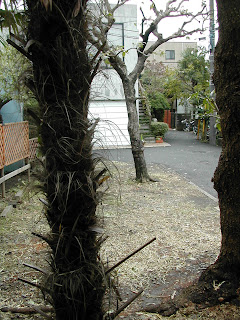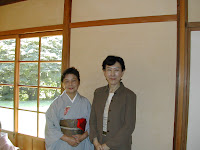
I took these photos on the way to a train station. It's close to my home.
For a while, I thought of moving back to Japan entirely. One of the reasons was Japan’s national healthcare. My son was in college. He could take care of the house. He would drive my car willingly! And my daughter was in high school and living with her dad. Through a former colleague of mine in Los Angeles, I landed on a technical manager position in Tokyo for an American software company. The company made systems monitor software and other innovative products.
The work was not easy but very interesting because of cultural differences. I learned a lot from all the employees and my boss. At the same time, I was going through many vague and unpleasant problems coming from after the death of Mother. She was larger than life to me and many people. It was a prior to year 2000, and systems programmers had choices. Y2K projects needed people like me. It would be easy for me to get a contract job in the U.S. I was lonesome, too. I had old friends, but no one really to talk to. So, whatever the problem feelings I had remained the same and that included the tree problem.

The tree problem continued because trees and bushes never stop growing. Then, a few weeks ago, Electro started to make a lot of noises about worms. I didn’t see worms, but as soon as I heard him talking about worms to a neighbor, I made sure not to look for them. I hate worms. Just thinking about them gave me shivers. So, I called my gardener.
“Worms will disappear once the weather cools down,” the gardener said.
Good. That seemed a good attitude and also a great solution. We just need to wait for colder weather. But my neighbor kept making noises about worms.
“Can you come as soon as possible? I’d like you to wipe out the bamboo bushes and trim all the trees. Please!”
“I can’t go right now. I’ll be there next week.”
Next day, someone knocked my door. Lately, some strangers knock my doors quite often if I remained in the apartment. And they don’t identify their name for some reason. Once, a stranger tried to open the door, and when I asked who that was, that person went away. In other time, I answered to a knock, and a woman replied to me as, “I’m a volunteer from the XXX Fourth town.” I live in the XXX Third town. I waited for more information such as what kind of volunteer work she was doing, and for what purpose she came over to me, and why she came four bus stops away to do her volunteer work. I was curious. She went away without further response. Something spooky has been going on here lately. The neighborhood used to be very safe, but not anymore.
Next day after I called the gardener, he called back and said,
“I got some free time tomorrow afternoon. I can’t do too much, but I will stop by.”
“Great! If you can clean out a part of the bamboo bush, I’ll be happy. That would stop the neighbor from bad mouthing the situation.”
So, the gardener came over. Electro and one of female neighbors were standing close to the gardener, staring at his work. I greeted and said to the gardener,
“Thank you for coming in such a short notice. If you could wipe right here, you can return for the rest next week,” I said. I pointed the bamboo bush near my door.
“Come over,” Electro said to me as though we were very close friends. “Come over. Come over here.”
“What is it?” I said. The gardener knelt down and kept cutting bamboos. Electro eyed him behind the gardener as though he wanted to avoid him in his secret talk with me. I felt respectful to the gardener even more. I didn’t want to talk behind his back. Besides, I have nothing to hide, and I have never been close to Electro.
“I say, come over here,” Electro insisted. “The worms were all over! You should have seen them.” He lifted a glass jar and extended his arm toward me. The jar looked like filled with some dirt. “Here, I kept worms for you to see.”
“I don’t want to see that.” I made a funny face and widened my nostrils. What was he thinking? If the worms were his problems, why he wanted to collect them into the jar and to show other people to feel worse?
He looked surprised that I didn’t want to see it. Then he said,
“I took care of your bamboo while you were gone and…”
He used to park his van for years in front of my apartment. He has no garden. He built his house up to the edge of his property. Once, he asked me after parking his car along the wall of my apartment,
“Do you want me not to park here?” he said to me.
“Well, I don’t own the lane,” I said.
“Tell me if you want me to park on my side,” he said.
“Oh, if you say so, okay, why don’t you park your car on your side since that’s your side? Because of a concrete block fence and a bamboo bush, people throw trash into it. When you park your van, it makes it even more hidden.”
He made an I-can’t-believe-what-you-are-saying look.
“Thank you for asking. That’s a good idea. Please don’t park here anymore.”
That was three years ago or so. Almost all the new houses being built are without a garden. I’m lucky to have it. Kids in the neighborhood gather at the corner of the lane and play ball. In summer, they collect cicadas from my trees. I enjoy listening to children play and bird and insect’s songs. Children can capture all the cicadas. I want to live next to this kind of natural environment, not walled by all concrete. But in the cities, owning trees and bushes comes with much responsibility and sometimes with unpleasantness.
A young friend of mine sent me an email. She knows what’s going on with my trees and bushes. I wrote that once the gardener finished their job, then Electro would finally be quiet. In reply, she wrote to me, “I don’t think he would stop.”
I imagined about Electro a year from now. Wow, I thought the young friend was quite observant. She must be right. Sometimes, nothing works for some people. And they remain the same. As I do! I guess that’s only fair.




















































